Did you know that carrots are one of the most popular vegetables grown by home gardeners? In fact, nearly 80% of American households have attempted to grow their own carrots at least once. Carrots are not only delicious and nutritious but also relatively easy to cultivate, making them a staple in many home gardens. If you’re looking to join the ranks of successful carrot growers, this comprehensive growing guide will show you how to choose, plant, and care for the best carrot seeds to ensure a bountiful harvest.
Key Takeaways:
- Carrots are a popular choice for home gardeners, with nearly 80% of American households attempting to grow them.
- This guide will provide expert tips on choosing and nurturing the best carrot seeds for a successful harvest.
- Understanding different carrot seed varieties is crucial in selecting the right seeds for your garden.
- There are various options for buying carrot seeds, including local stores and online retailers.
- Proper planting, nurturing, and care techniques are essential for the successful growth of carrot plants.
Understanding Different Carrot Seed Varieties
Carrot seeds come in a variety of options, including heirloom and organic varieties. Heirloom carrot seeds are open-pollinated and have been passed down through generations for their unique characteristics and flavors. They offer a taste of history and tradition in your garden. On the other hand, organic carrot seeds are grown without synthetic fertilizers or pesticides, making them a great choice for those practicing organic gardening.
Heirloom Carrot Seeds
Heirloom carrot seeds are the result of careful cultivation and preservation. They are open-pollinated, meaning they rely on natural pollination methods such as wind or insects. These seeds have been handed down through generations, preserving their distinct traits and flavors. Heirloom carrots come in a range of colors, shapes, and sizes, offering diversity and novelty to your homegrown harvest. With their rich history and unique characteristics, heirloom carrot seeds are a popular choice for gardeners seeking something extraordinary.
Organic Carrot Seeds
For those practicing organic gardening or seeking chemical-free produce, organic carrot seeds are the way to go. These seeds are produced without the use of synthetic fertilizers, pesticides, or genetically modified organisms (GMOs). Organic farming methods prioritize soil health and natural pest control, resulting in healthier and more environmentally friendly produce. By choosing organic carrot seeds, you can grow nutritious and safe carrots while contributing to sustainable agriculture.
By understanding the different carrot seed varieties available, you can make an informed decision when selecting seeds for your garden. Whether you opt for the rich history of heirloom carrot seeds or the sustainable practices of organic carrot seeds, both options offer unique benefits and the potential to grow delicious, homegrown carrots.
| Carrot Seed Variety | Description |
|---|---|
| Heirloom Carrot Seeds | Open-pollinated, passed down through generations, unique flavors and characteristics, diverse colors, shapes, and sizes |
| Organic Carrot Seeds | Grown without synthetic fertilizers or pesticides, environmentally friendly, safe and nutritious produce |
Buying Carrot Seeds: Where to Look
When it comes to buying carrot seeds, you have several options to choose from. You can find them at local gardening stores, nurseries, or hardware stores in your area. These brick-and-mortar establishments offer the advantage of being able to inspect the seeds in person and seek advice from knowledgeable staff.
However, there is another convenient option available – buying carrot seeds online. Shopping online provides a wide selection of carrot seed varieties and the convenience of having them delivered right to your doorstep. It’s a great option for busy individuals or those who prefer the ease of online shopping.
When looking for carrot seeds online, there are reputable seed companies and dedicated marketplaces that specialize in selling seeds. These platforms offer a vast array of carrot seed varieties, ensuring you can find the perfect ones for your garden.
Consider your preferences and convenience when deciding where to buy your carrot seeds. Whether you choose a local store or opt for online shopping, the key is to find a reliable source that offers high-quality seeds.
| Where to Buy Carrot Seeds? | Advantages |
|---|---|
| Local Gardening Store, Nursery, or Hardware Store |
|
| Online Seed Companies and Marketplaces |
|
Planting and Nurturing Carrot Seeds
Planting carrot seeds is an essential step in growing your own delicious carrots. By following the right techniques and providing proper care, you can nurture your carrot seeds into thriving plants. Let’s explore the process of planting and nurturing carrot seeds to ensure a successful harvest.
Preparing Your Garden Beds
Before planting carrot seeds, it’s crucial to prepare your garden beds properly. Start by removing any weeds and loosening the soil to ensure it’s well-draining. This will provide the ideal conditions for your carrot seeds to germinate and grow.
Choosing the Best Carrot Seeds
Selecting high-quality carrot seeds is essential for a successful harvest. Look for varieties that perform well in your climate and consider factors like taste, size, and color. Organic and heirloom carrot seeds are often preferred by gardeners for their unique flavors and sustainable growing practices.
Planting Carrot Seeds
When it comes to planting carrot seeds, timing is key. Carrots prefer cool weather, so it’s best to plant the seeds in early spring when soil temperatures reach about 50 degrees F. Here’s a step-by-step guide to planting your carrot seeds:
- Prepare your garden bed by creating rows and spacing the seeds about 6-8 inches apart.
- Plant the carrot seeds slightly deeper than recommended, ensuring they are covered with a thin layer of sifted compost or soil.
- Water the carrot seeds regularly to keep the soil moist, but avoid overwatering.
- Thin the seedlings once they start sprouting to give them enough space to grow.
- Continue watering and weeding to provide consistent care for your carrot seeds.
Nurturing Carrot Seeds
As your carrot seeds develop into seedlings, it’s essential to provide them with proper care and attention. Here are some tips for nurturing your carrot seeds:
- Water your carrot seeds regularly, ensuring the soil remains moist but not overly saturated.
- Monitor for any signs of pests or diseases and take appropriate measures for control.
- Provide adequate spacing between the seedlings to allow for healthy growth.
- Continue to water and weed your carrot plants to ensure optimal conditions for their development.
Remember, patience is key when growing carrots from seed. It may take a few weeks for the seeds to germinate, but with proper care, you’ll soon be enjoying a bountiful harvest of homegrown carrots!
Tips for Successful Carrot Germination
Carrots have a long germination time, which can take up to three weeks. To improve germination rates, follow these tips:
- Plant carrot seeds in cool weather when the soil temperature is between 55 and 75 degrees F.
- Plant carrot seeds slightly deeper than recommended and cover them with a thin layer of sifted compost or soil. This helps retain moisture and provides better conditions for germination.
- Water your carrot seeds regularly, keeping the soil moist but not overly saturated.
Following these tips will increase the success of your carrot germination.
“To improve germination rates, plant carrot seeds in cool weather, slightly deeper than recommended, and water regularly.”
Comparison of Carrot Seed Germination Techniques
| Technique | Advantages | Disadvantages |
|---|---|---|
| Planting in cool weather | Provides optimal conditions for germination | Requires monitoring soil temperature |
| Planting slightly deeper | Improves moisture retention and seedling establishment | May require additional soil preparation |
| Regular watering | Ensures consistent moisture for germination | Requires careful monitoring to avoid overwatering |
Planting carrot seeds in optimal conditions and providing proper care will lead to successful carrot germination. Remember to monitor soil temperature, plant slightly deeper, and water regularly. Happy gardening!
Growing Healthy Carrot Plants
Growing healthy carrot plants requires proper care throughout their growth stages. With a little attention and nurturing, you can ensure that your carrot plants thrive in your garden. Here are some essential tips to help you grow robust and nutritious carrots.
1. Optimal Watering
Water is essential for the healthy development of carrot plants. Keep your carrot plants well-watered, providing at least 1 inch of water per week. Be sure to water deeply to encourage roots to grow down into the soil. Avoid overwatering, as excessive moisture can lead to rot or disease. Regularly check the moisture level of the soil and adjust your watering schedule accordingly. Adequate hydration will contribute to the growth and quality of your carrot plants.
2. Mulching for Moisture Retention
Mulching around your carrot plants can help retain moisture in the soil, preventing it from drying out too quickly. Apply a layer of organic mulch, such as straw or shredded leaves, around your plants. Mulching not only helps conserve moisture but also suppresses weed growth, providing a tidy and healthy environment for your carrots to grow.
3. Pest and Disease Control
Nurturing carrot plants also involves protecting them from pests and diseases. Regularly inspect your plants for signs of pests like aphids or diseases like carrot rust fly. If you notice any issues, take appropriate measures to control the problem. Consider using organic pest control methods or natural remedies to keep your carrot plants healthy without the use of harmful chemicals.
“Prevention is key when it comes to managing pests and diseases in your carrot garden. Regularly inspecting your plants and taking prompt action can significantly reduce the risk of damage and ensure the success of your harvest.” – Gardening Expert
4. Nutrient Boost
Carrot plants benefit from proper nutrition to support their growth and development. Fertilize your carrot plants around 5-6 weeks after planting with a low-nitrogen fertilizer. Too much nitrogen can result in lush foliage but stunted or misshapen roots. A balanced fertilizer with higher phosphorus and potassium content helps promote root growth and overall plant health. Follow the manufacturer’s instructions for application rates and frequency to avoid over-fertilizing.
By providing the necessary care and attention, you can ensure the health and vitality of your carrot plants. Whether you’re a seasoned gardener or a beginner, following these tips will contribute to the successful growth of your carrot plants and the enjoyment of your homegrown harvest.
Harvesting and Storing Carrots
Harvesting carrots at the right time is crucial for their flavor and texture. Carrots are typically ready to harvest when they reach finger size or are about ½ inch in diameter. Gently pull them up from the soil, being careful not to damage the roots.
“Harvesting carrots at the peak of their ripeness ensures their sweet and tender taste.”
After harvesting, remove the foliage, leaving about 1/2 inch of the tops, and wash off any dirt. To store fresh carrots, you have a couple of options. You can seal them in airtight plastic bags and refrigerate them, which helps retain their crispness and flavor. Alternatively, you can store them in tubs filled with moist sand or dry sawdust in a cool, dry area. This method is ideal for longer-term storage, as it creates a humid environment that prevents the carrots from drying out.
Properly harvested and stored carrots can last for several months. Here’s a comparison of storage methods:
| Storage Method | Advantages | Disadvantages |
|---|---|---|
| Refrigeration | – Retains crispness – Convenient and easy – Suitable for short-term storage |
– Requires refrigerator space – Carrots can still dry out over time |
| Stored in sand/sawdust | – Creates a humid environment, preventing drying – Ideal for longer-term storage – Preserves freshness and flavor |
– Requires additional storage space – Requires monitoring for moisture levels |
Proper storage conditions are essential to maintain the quality of your harvested carrots. Whether you choose to refrigerate or store them in sand or sawdust, regularly inspect your stored carrots for any signs of spoilage or degradation. Discard any carrots that show signs of softness, mold, or decay to prevent the spread of deterioration to other carrots.
By harvesting at the right time and employing proper storage techniques, you can enjoy your homegrown carrots for months to come.
Common Problems and Solutions for Growing Carrots
Growing carrots can be a rewarding experience, but it’s not without its challenges. In this section, I will discuss common problems that gardeners face when growing carrots, along with effective solutions to overcome them. By being aware of these issues and taking preventive measures, you can ensure the optimal growth and yield of your carrot plants.
1. Carrot Fly Damage
One of the most common problems with growing carrots is damage caused by carrot flies. These pests lay their eggs near the base of the carrot plants, and the resulting larvae feed on the roots, leading to stunted and deformed carrots.
To prevent carrot fly damage:
- Practice crop rotation: Avoid planting carrots in the same location year after year to disrupt the life cycle of carrot flies.
- Use row covers: Cover your carrot plants with fine mesh or floating row covers to create a physical barrier that prevents carrot flies from reaching them.
2. Leaf Blights
Leaf blights are fungal diseases that can affect carrot plants, causing yellowing, wilting, and browning of the leaves. This can weaken the plants and lead to poor root development.
To prevent leaf blights:
- Select disease-resistant carrot varieties that are less susceptible to leaf blights.
- Avoid overhead watering, as wet foliage creates favorable conditions for fungal growth.
- Space your carrot plants adequately to promote good air circulation, reducing the chances of fungal infection.
3. Root Rot
Root rot is another common problem that can affect carrot plants, especially in poorly drained soils. It is caused by fungal pathogens that attack the roots, causing decay and rotting.
To prevent root rot:
- Ensure proper soil drainage by incorporating organic matter or amending the soil with sand in heavy clay soils.
- Practice crop rotation to reduce the buildup of fungal pathogens in the soil.
- Avoid over-watering and maintain appropriate soil moisture levels.
4. Pests and Diseases
Garden pests, such as aphids, nematodes, and slugs, can also pose a threat to your carrot plants. Additionally, diseases like powdery mildew and bacterial canker can affect the overall health and productivity of your carrots.
To prevent pests and diseases:
- Regularly inspect your carrot plants for any signs of infestation or disease. Remove any affected plants immediately to prevent the spread.
- Implement integrated pest management techniques, such as using organic pest controls or beneficial insects to manage pests.
- Practice good hygiene by cleaning garden tools and equipment to prevent the spread of diseases.
Solutions Table:
| Problem | Solution |
|---|---|
| Carrot Fly Damage | Practice crop rotation, use row covers |
| Leaf Blights | Select disease-resistant carrot varieties, avoid overhead watering, promote good air circulation |
| Root Rot | Ensure proper soil drainage, practice crop rotation, maintain appropriate soil moisture levels |
| Pests and Diseases | Regular inspection, implement integrated pest management techniques, practice good hygiene |
By implementing these preventive measures and staying vigilant in caring for your carrot plants, you can minimize the impact of common problems and ensure a successful carrot-growing experience.
Conclusion
Growing carrots from seeds can be a fulfilling and rewarding endeavor. By carefully selecting the right carrot seeds and implementing proper planting and care techniques, you can cultivate a thriving garden of fresh, flavorful carrots. Whether you prefer organic or heirloom varieties, there are numerous carrot seed options available to cater to your unique preferences.
With patience and dedication, you can nurture your carrot plants and witness the joy of harvesting your very own delicious carrots. The process of growing carrots from seeds allows you to have full control over the entire journey, from sowing the seeds to reaping the rewards.
Whether you’re a seasoned gardener or a beginner, the journey of growing carrots can be both exciting and educational. Discover the wide range of carrot seed varieties and experiment with different flavors and textures in your garden. With each successful harvest, you’ll not only savor the taste of your homegrown carrots but also gain a deeper appreciation for the art of gardening.

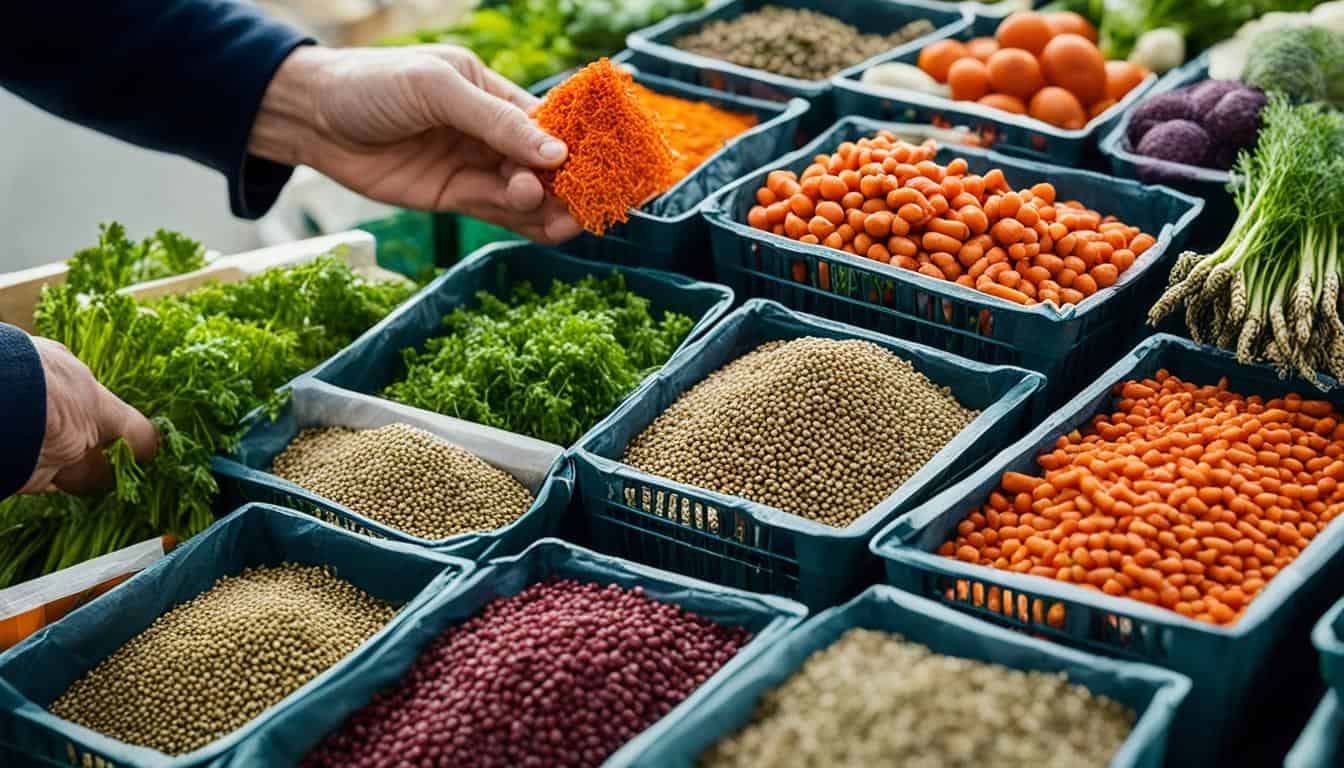

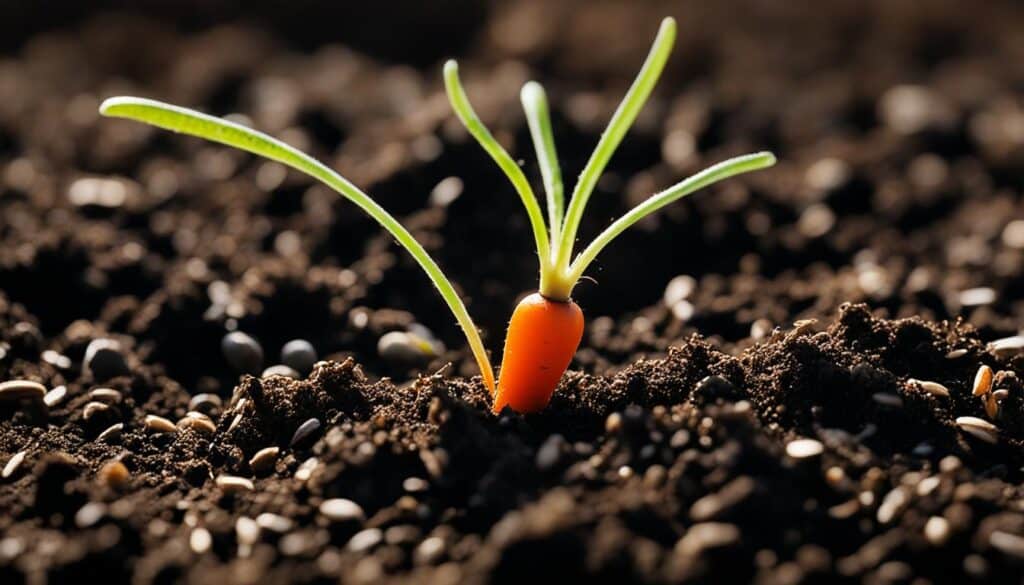
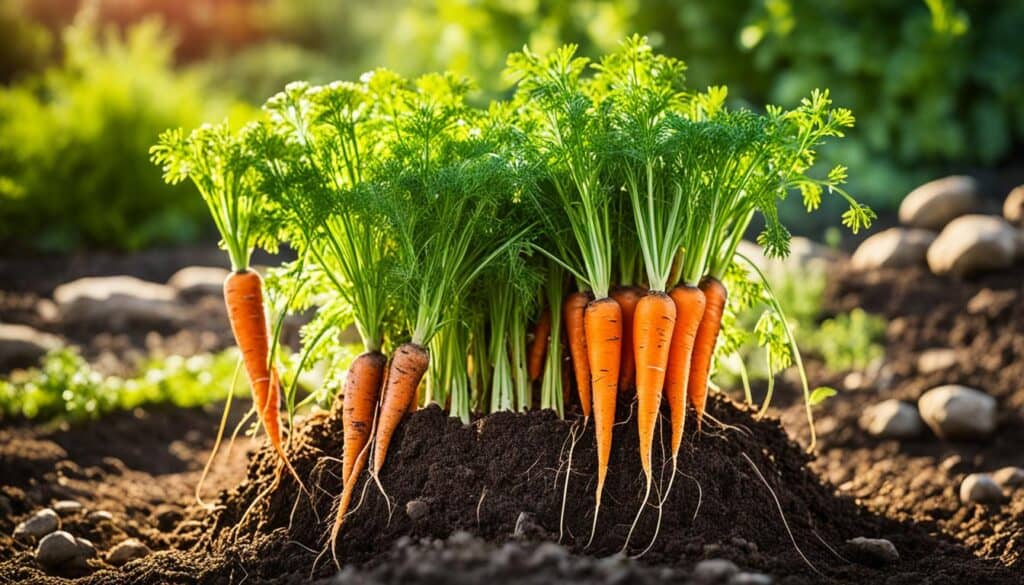
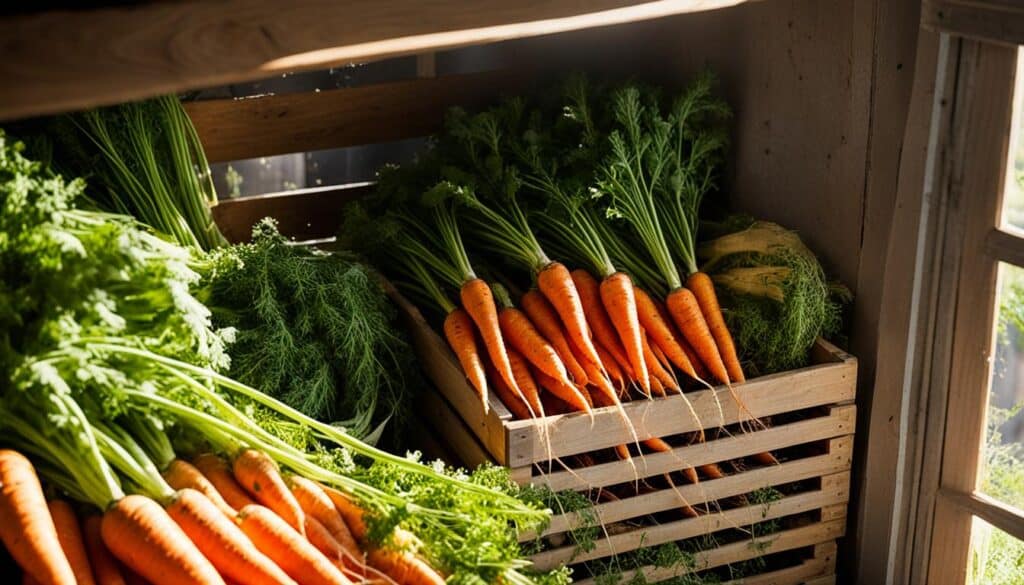
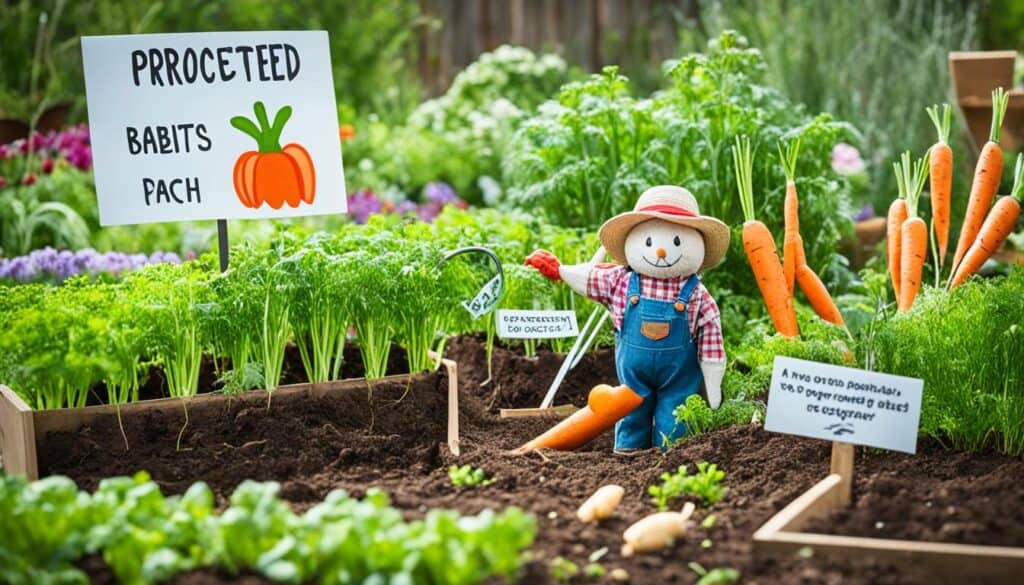



Leave a Reply